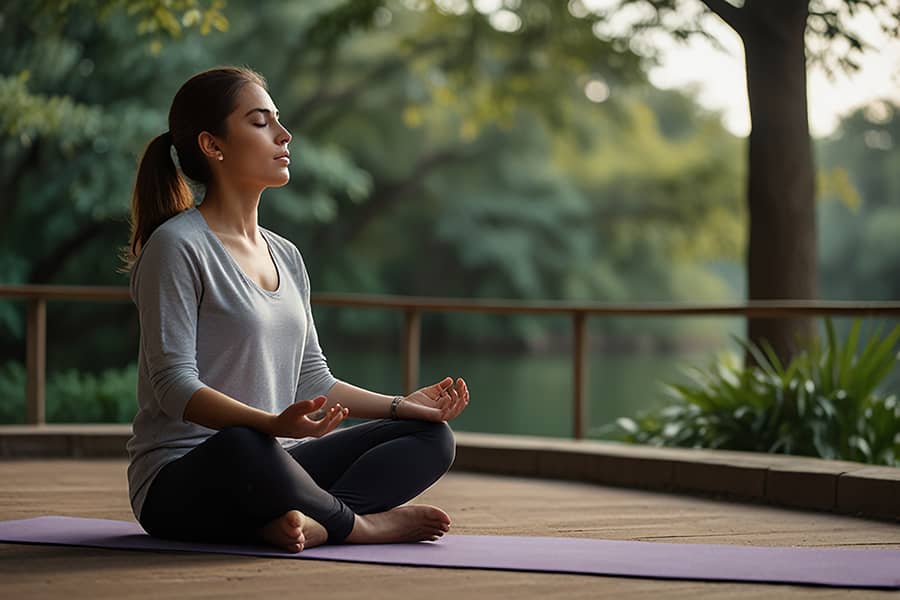The Power of Breathwork: Transform Your Mental State Today!

Introduction: Understanding Breathwork and Its Benefits
Breathwork is not just a practice; it’s an intimate journey into the depths of our being. By harnessing the power of our breath, we can tap into a natural form of healing that transcends conventional methods. This ancient practice unravels layers of tension and emotional baggage, allowing us to experience profound states of relaxation and heightened awareness. When we actively engage with our breathing patterns, we create space for introspection and self-discovery, making it a gateway to mental clarity and emotional resilience.
One particularly compelling aspect of breathwork is its ability to influence our nervous system. Various techniques can induce states akin to meditation or even altered consciousness, triggering the release of endorphins—the body’s natural mood enhancers. Engaging in regular breathwork sessions can lead to decreased anxiety, improved focus, and an overall enhancement in well-being. Furthermore, as we transform our mental state through intentional breathing exercises, we foster a deeper connection with ourselves and those around us—a ripple effect that enriches every facet of life.
What is Breathwork? An Overview
Breathwork is far more than just a simple concept of breathing; it’s an ancient practice intertwining mindfulness and physiological understanding to enhance mental clarity and emotional well-being. By consciously regulating breath patterns, such as through techniques like deep diaphragmatic breathing or rhythmic inhalation and exhalation, individuals can tap into a reservoir of untapped energy and altered states of consciousness. This interplay between breath and brain chemistry allows practitioners to alleviate stress, process emotions, and foster resilience in the face of daily challenges.
Emerging research highlights the profound impact of breath on our nervous system. For instance, specific breathing exercises can stimulate the vagus nerve—our body’s natural calming agent—thereby reducing anxiety levels while promoting relaxation. Moreover, many individuals find that developing a personalized breathwork routine not only enhances their meditative practices but also creates a conscious pause in everyday life, allowing for deeper introspection and connection with oneself. In this fast-paced world where distractions abound, embracing breathwork provides an invaluable opportunity to anchor ourselves back into the present moment, cultivating both peace within our minds and strength within our spirits.
The Science Behind Breath and Mental Health
Breath is more than just a biological necessity; it’s a powerful tool that can alter our mental landscape. Scientific studies have shown that controlled breathing techniques, such as diaphragmatic or box breathing, can significantly lower cortisol levels—our body’s primary stress hormone. This physiological response not only calms the mind but also enhances emotional regulation, allowing us to pivot from feelings of anxiety and overwhelm toward clarity and peace. Moreover, engaging in breathwork activates the parasympathetic nervous system, which promotes relaxation and helps restore balance in our emotional state.
Recent neurological research reveals an intriguing connection between breath patterns and brain activity. When we consciously shift our breathing rhythm—slowing it down or deepening each inhalation—we stimulate areas of the brain associated with calmness and focus. For instance, steadying your breath while meditating can increase activity in the prefrontal cortex, a region linked to decision-making and self-control. This indicates that intentional breathing exercises may not only reduce symptoms of depression or anxiety but could also strengthen cognitive functions over time. By harnessing this simple yet profound act of inhalation and exhalation, we empower ourselves to navigate life’s challenges with greater resilience and insight.
Types of Breathwork Techniques Explained
Breathwork encompasses a diverse array of techniques, each designed to unlock the power of our breath for emotional healing and personal transformation. For example, **Holotropic Breathwork** utilizes accelerated breathing patterns in a safe setting, often accompanied by evocative music. This practice allows individuals to access altered states of consciousness, facilitating deep self-exploration and integration of past trauma. Participants often report profound insights and cathartic releases that rejuvenate their mental state.
On the other hand, **Box Breathing** offers a structured approach that cultivates calmness and focus; it involves inhaling for four counts, holding for four counts, exhaling for four counts, and pausing again for another four counts. This technique not only assists in managing anxiety but also improves concentration—the perfect combination for high-stress environments or busy workdays. Meanwhile, *Wim Hof Method* integrates breath control with cold exposure exercises, promoting resilience and enhancing mood through increased oxygen supply and adrenaline release. Each technique brings something unique to the table—personalizing your breathwork practice can lead to transformative experiences tailored specifically to your needs.
How to Start Your Breathwork Practice
Starting your breathwork practice is an exciting journey into self-discovery and transformation. Begin by creating a dedicated space where you can immerse yourself in the experience—this could be a quiet corner of your home, adorned with calming elements like soft lighting or natural scents. As you settle in, take a moment to bring awareness to your body and mind; simply acknowledging any emotions or thoughts can deepen your connection to the process.
When you’re ready, start with simple techniques like diaphragmatic breathing. Inhale deeply through your nose for a count of four, allowing your abdomen to rise as opposed to just filling your chest. Then slowly exhale through your mouth for another count of four. This rhythmic approach not only anchors you in the present but also promotes relaxation and clarity as engagement with each breath becomes more intentional over time.
As you grow comfortable, experiment with different styles such as box breathing or alternate nostril breathing to find what resonates most with you. Keep track of how each technique affects your mood and physical sensations, turning it into an engaging dialogue between mind and body. Remember that breathwork is uniquely personal; honor what feels good while exploring new methods that challenge you—this dance of discovery can empower profound shifts in perspective for everyday life.
Creating a Safe Space for Breathwork
Creating a safe space for breathwork goes beyond physical comfort; it involves nurturing an environment where participants feel fully at ease to explore their emotional landscapes. Dim lighting, soft textures, and calming scents can set the stage, but the heart of safety lies in establishing trust among participants. Encourage open communication about intentions and boundaries, allowing individuals to express their needs without fear of judgment. This vulnerability paves the way for deeper connection and expansive experiences during the practice.
Incorporating elements of mindfulness enhances this safe space. Consider beginning sessions with grounding exercises that connect everyone to the present moment—simple body scans or gentle stretching can help release tension before diving deeper into breathwork practices. As individuals learn to focus on their breath, they also cultivate self-awareness that reinforces their ability to navigate discomfort with compassion. When everyone feels secure emotionally and physically, they are empowered to let go of inhibitions, unlocking profound transformations through each conscious inhale and exhale.
Common Challenges in Breathwork Sessions
Navigating breathwork sessions can reveal a host of common challenges that practitioners might not anticipate. One significant hurdle is the mind’s tendency to wander. As participants delve into their breath, thoughts about daily responsibilities, past events, or future concerns can flood in, creating distractions that detract from the experience. Learning to gently redirect focus back to the breath serves as a pivotal skill—one that mirrors life’s broader lesson of mindfulness amidst chaos.
Another challenge lies in physical discomfort. Holding certain positions or focusing intently on breathing patterns may lead to tension or aches in the body, which can inhibit relaxation and diminish the session’s effectiveness. Cultivating awareness of one’s physical limitations and choosing comfortable postures promotes a more enjoyable practice and enhances connection with one’s body during breathwork. Developing patience with oneself through these obstacles encourages deep personal insights and growth, transforming each session into an opportunity for self-discovery rather than mere exertion.
Lastly, vulnerability often emerges as a double-edged sword within group settings; while sharing space with others can foster community and support, it may trigger feelings of insecurity or fear about exposing one’s emotions. Embracing this emotional release requires courage but leads to profound healing when approached openly. By recognizing these challenges—not just as barriers but as gateways for deeper understanding—practitioners can enrich their journey into the transformative realm of breathwork.
Real-Life Transformations Through Breathwork
Individuals across the globe are discovering that breathwork is not just a practice; it’s a gateway to profound transformation. Take Sarah, for instance, who once battled debilitating anxiety and insomnia. After integrating breathwork into her daily routine, she found solace in simple breathing techniques that calmed her racing mind and anchored her in the present moment. Each session became a sanctuary where she could process her emotions and emerge with renewed clarity and purpose.
Similarly, Jason’s journey through grief was forever changed when he started exploring conscious breathing practices. Where he once felt suffocated by sorrow, deep diaphragmatic breaths helped him access unprocessed feelings while gently releasing pent-up energy. The rhythmic cadence of his breath evolved from a source of pain into a powerful tool for healing—one that allowed him to honor his loss while paving the way toward acceptance and hope. These narratives illustrate that breathwork does more than shift mental states; it fosters resilience, enabling individuals to reclaim their emotional landscapes with grace and strength.
Tips for Consistency in Your Practice
Establishing consistency in your breathwork practice can be more transformative than you might expect. One effective approach is to create a dedicated space that is both inviting and free from distractions. This doesn’t mean it has to be elaborate; a corner of your room with a comfortable cushion and soft lighting can serve as your personal sanctuary. Associating this space with mindfulness will condition your mind to shift into a state of openness and calm as soon as you enter.
Another powerful tip is to integrate breathwork into daily routines, such as before meals or at bedtime. By anchoring your practice to these regular activities, you ensure it becomes an organic part of your day rather than an optional task on your to-do list. Additionally, keeping a journal can enhance self-awareness by tracking progress, emotions, and insights after each session—providing motivation during those inevitable lulls in enthusiasm. Embracing flexibility within structure allows for growth while maintaining the rhythm required for lasting change; don’t hesitate to mix up techniques or durations based on what resonates most at any moment. Ultimately, it’s about finding what works uniquely for you and honoring that journey toward deeper mental clarity through the power of breath.
Conclusion: Embrace the Power of Your Breath
In the grand tapestry of our existence, breath serves as a vital thread that connects our physical selves to our emotional and spiritual realms. When we consciously embrace the power of our breath, we unlock a wellspring of potential that can lead to profound transformations. Each inhalation becomes an opportunity—a chance to invite vitality, clarity, and renewed purpose into our lives, while each exhalation releases the burdens of stress and negativity. This rhythmic dance harmonizes mind and body, allowing us to navigate life’s complexities with grace.
By integrating breathwork into your daily routine, you cultivate more than just relaxation; you forge a deeper connection with your innermost self. Imagine harnessing this capacity for transformation in moments of uncertainty or overwhelm—your breath becomes both an anchor and a beacon. Whether it’s through guided sessions or simple mindfulness practices at home, embracing this ancient tool cultivates resilience and fosters emotional intelligence. As you gradually deepen your breathing technique, you’ll find that you not only enhance mental clarity but also enrich every interaction in your life with newfound authenticity.
Ultimately, the journey toward mastering breath isn’t merely about stress relief; it’s an invitation to rediscover joy and presence amid life’s chaos. The power is already within you—waiting for your conscious acknowledgment. So take a moment now: inhale deeply, reclaim that intensity of being alive in this very moment, and exhale any remnants of doubt. Embrace this gift wholeheartedly; transform not only how you perceive yourself but also how you engage with the world around you.
Recent Posts
-
Advice for achieving a healthier and more joyful lifestyle
September 16, 2024




